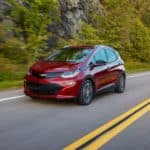EVs might offer a number of advantages over their gas-burning predecessors, but cold-weather performance isn’t one of them. The massive batteries that power today’s EVs are particularly susceptible to the cold, sacrificing up to 25% of their range at highway speeds and up to 50% when driving around town. Some models perform better in cold temperatures than others, with EVs from Tesla, Audi, and Jaguar losing as little as 3% to 15% of their battery power compared to anywhere between 24% and 32% for some of the all-electric offerings from Chevy, Ford, and BMW.
This gulf in winter performance is part of the reason why it’s so important to do your research when choosing your next EV, as weighing factors like heating efficiency, all-wheel drive, and a battery preconditioning system can go a long way toward improving your chances of cold-weather success. Let’s walk through some of the features a driver should consider when selecting a winter-worthy ride and see which of today’s EVs are ready to play in the snow and which should be put away for the winter.
Features to Consider
Heat Pumps
Most drivers don’t realize that their vehicle’s heating system is entirely dependent on the engine. While cooling duties are handled by an independent compressor, condenser, and evaporator, the heater basically just captures excess engine heat and directs it into the cabin via a series of blower fans. This approach might work well for internal combustion vehicles, but the fact that EVs lack a gas-burning engine presents some real problems when it comes to keeping the cabin cozy on a cold winter day.
Without a 200°F engine under the hood, EVs have to produce their own heat from scratch, putting a strain on the battery and reducing the vehicle’s overall range. In order to engineer around this problem, several automakers have turned to heat pumps to warm the cabin as efficiently as possible. These pumps capture air, compress it, and siphon the heat from a condenser to both warm the interior and keep the battery within the ideal temperature range. It’s similar to the technology used to keep a refrigerator cool, only in reverse, and it has become an increasingly popular option for homeowners looking to reduce their heating and cooling costs.
The numbers certainly back up the heat pump approach; EVs designed with heat pumps boast an efficient rating of around 3.2 miles/kWh compared to 2.9 miles/kWh for those without. Tesla is the only brand to offer heat pumps across its entire EV lineup, but models like the Hyundai IONIQ 5, Audi Q8 e-tron, Kia EV9, and Jaguar i-Pace have also embraced the technology. Other models like the Chevrolet Bolt and Bolt EUV use a resistance heating system that, while less efficient, is still an improvement over a standalone heater.
Heated Seats and Steering Wheels
Blowing hot air out of the dashboard vents isn’t the only way to keep a vehicle warm. While a traditional heating system or heat pump certainly makes for a comfortable cabin, other forms of heating are often more efficient and just as useful. A number of automakers have made heated seating and steering wheels a standard feature in many of their EVs, allowing drivers to enjoy a warm ride with a minimal impact on battery power and range. When it comes to traditional gas-powered vehicles, heated seats and steering wheels are generally thought of as luxury add-ons, but they’re a vital part of the package when you swap over to an electric powertrain.
It makes a lot of sense when you think about it: aside from the pedals, the seat and steering wheel are really the only two components that come into contact with the driver as they cruise down the road. By directly heating the seat and steering wheels, EVs can keep the driver and passengers warm without heating the entire cabin. Heated seats and steering wheels are included in a wide range of EVs, either as standard equipment or optional extras.
This includes both models that employ heat pumps and those that opt for a traditional heating system, so it’s important to read the fine print when shopping for your winter-worthy EV. The Audi Q8 e-tron, BMW i4 and iX, Chevrolet Bolt and Bolt EUV, Ford Mustang Mach-E and F-150 Lightning, Kia EV6, and Toyota bZ4X all offer heated seats and steering wheels as optional extras or reserve them for higher trims while they’re part of the standard package on the Nissan ARIYA and Volvo XC40 Recharge.
All-Wheel Drive
All-wheel drive (AWD) is a must-have feature for any driver who regularly finds themselves navigating ice, snow, and other challenging winter weather. Winter driving is all about maximizing traction, and the ability to propel all four wheels can mean the difference between a safe, confident ride and one that leaves you swerving all over the road. In gas-powered vehicles, adding an AWD system can be an expensive proposition; this is why AWD is typically reserved for larger trucks, SUVs, and other vehicles that regularly face tough road conditions. Luckily, it’s a different story when it comes to EVs.
Throwing an extra electric motor onto the rear axle isn’t that much of a hassle since, unlike an internal combustion vehicle, it doesn’t require a bunch of additional hardware to transfer the power from the engine to the rear wheels. An AWD EV will sacrifice a bit of range in exchange for the added traction, but it’s a small price to pay when you consider the safety implications. 2024 EVs that are available with AWD include the Audi Q8 e-tron, Cadillac LYRIQ, GMC Hummer EV, Kia EV9, BMW i4, i5, i7, and iX, and the Chevy Blazer and Silverado EV.
Ground Clearance
There’s no underestimating the importance of ground clearance when choosing your next winter vehicle. A vehicle that has plenty of loft can glide over snow and slush while one that rides a little too low might turn into a sort of involuntary snow plow. In order to improve aerodynamics and range, many brands have opted to get their EVs as low to the ground as possible, but there are plenty of all-electric crossovers like the Kia EV9, Tesla Model Y, and Audi Q8 e-tron that make ground clearance a priority.

Preconditioning
The batteries that power today’s EVs are marvels of modern engineering, but they’re not without their drawbacks. In order to work its best, an EV’s battery needs to be kept within a pretty narrow temperature band. When it’s too cold—or too hot—the battery can have a difficult time translating its chemical energy into the electric energy required to move you down the road. A cold, inefficient battery will not only impact range and driving performance but can also take longer to charge and lead to premature degradation of an EV’s single-most expensive component. This is where battery preconditioning comes in.
A common feature of most EVs, battery preconditioning allows a vehicle to automatically warm the battery to its ideal operating temperature. Battery reconditioning systems vary by brand. While some EVs can only perform this trick when the vehicle is connected to a charger, others can get the battery up to the correct temperature all on their own.
Accessibility also differs between brands. Many EVs require drivers to activate or schedule the preconditioning feature through the dashboard infotainment display, but models from brands like Ford, Chevy, Tesla, and BMW can be controlled through connected smartphone apps from the comfort of your kitchen table. Tesla’s EVs can even automatically precondition the battery when the vehicle detects a scheduled charging stop and brings it to the ideal temperature for a quick, smooth fill-up.
Battery preconditioning can usually be accomplished within 30 minutes, but it all depends on how low the thermometer is on any given day. If you’re the type of driver who values a little extra time in bed or is eager to maximize your range, a smartphone-based preconditioning system might be a make-or-break factor when choosing an EV.
Best Cold-Weather EVs
Audi Q8 e-tron
Range: 300 miles
Range at 32°F: 80% of Original EPA Range
Heat Pump System: Yes
Heated Seats/Steering Wheel: Yes
All-Wheel Drive: Yes
Ground Clearance: 8.1 inches
Battery Preconditioning: Yes
With 8.1 inches of ground clearance, the Audi Q8 e-tron rides higher than any of the other EVs on this list. While it’s a pretty well-rounded offering, it does fall a bit short when it comes to cold-weather range.
Kia EV9
Range: 304 miles
Range at 32°F: 85% of Original EPA Range
Heat Pump System: Yes
Heated Seats/Steering Wheel: Yes
All-Wheel Drive: Yes
Ground Clearance: 7 inches
Battery Preconditioning: Yes
In contrast to the Audi, the Kia EV9 is notable for its cold-weather performance. This EV can maintain 85% of its EPA-estimated range when the temperature starts to drop and comes with all the goodies that make it an instant contender for the cold-weather crown.
Tesla Model Y
Range: 320 miles
Range at 32°F: 82% of Original EPA Range
Heat Pump System: Yes
Heated Seats/Steering Wheel: Yes
All-Wheel Drive: Yes
Ground Clearance: 6.8 inches
Battery Preconditioning: Yes
The Tesla Model Y boasts the longest range of the bunch, though it does ride a little lower to the ground than some of its competitors. This might not be that much of an issue in terms of the Standard and Long-Range trims, but the Performance version loses an additional 0.5 inches in the name of aerodynamics to drop down to 6.3 inches.
Nissan ARIYA
Range: 304 miles
Range at 32°F: 85% of Original EPA Range
Heat Pump System: Yes
Heated Seats/Steering Wheel: Standard
All-Wheel Drive: Yes
Ground Clearance: 6.3 inches
Battery Preconditioning: Yes
The Nissan ARIYA might not excel in any one category, but its real value comes down to its impact on your wallet. Starting at just $40,000, the ARIYA is a relative steal in the EV segment. It’s also one of the only models that comes standard with a heated steering wheel and seats.

Volvo XC40 Recharge
Range: 293 miles
Range at 32°F: 80% of Original EPA Range
Heat Pump System: Yes
Heated Seats/Steering Wheel: Standard
All-Wheel Drive: Yes
Ground Clearance: 6.9 inches
Battery Preconditioning: Yes
The Volvo XC40 Recharge also comes standard with a heated steering wheel and seats, but its range, cold-weather performance, and ground clearance are nothing to write home about. On the other hand, this EV maintains Volvo’s rock-solid reputation for safety, which is another important factor to keep in mind when shopping for a winter vehicle.
Running Warm in the Cold
In many ways, today’s EVs aren’t that much different from the gas-powered models that have dominated the market for the past century, but that doesn’t hold true when you start examining cold-weather performance. Freezing temperatures can wreak havoc on an EV’s range, as can something as simple as cranking up the heating system. If you live in an area that regularly experiences harsh winter weather, picking the right EV for your environment is essential.
I’ve outlined some of the industry’s best EVs, from those with the best cold-weather range and ground clearance to ones that include critical winter gear like AWD, heat pumps, and heated seats and steering wheels as standard equipment. The list is largely dominated by crossover SUVs which, in addition to their ample ground clearance, also tend to be offered with AWD. That said, there are plenty of options to explore when picking a new EV, with more options hitting the market with every passing year. Check back in now and again as I continue to track these trends and help you find the perfect vehicle for your driving needs.



